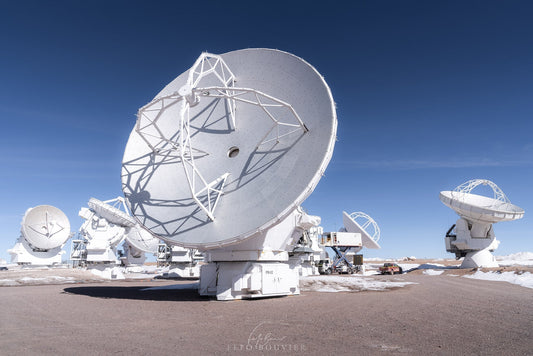This past July, I fulfilled a lifelong dream: visiting some of the world’s most important telescopes in northern Chile, a region renowned for having the best conditions on Earth for astronomical observation. The journey made me reflect on astronomy as a human endeavor—one as vast and awe-inspiring as the cosmos itself—and left me gazing at the skies of my own country with a renewed sense of wonder.
This was possible thanks to my selection as one of ten ambassadors for the Astronomy in Chile Educator Ambassadors Program (ACEAP), a collaboration between Associated Universities Inc. (AUI) and the Association of Universities for Research in Astronomy (AURA), and the telescopes they manage in Chile, which are part of NOIRLab and NRAO/ALMA . As the first Uruguayan to participate in this program, I shared the experience with astronomers, educators, and artists from Chile, the United States, Puerto Rico, France, Spain, and Italy.

The program's mission is to provide communication training about U.S. astronomy facilities in Chile through an intensive agenda that included talks about the various institutions that make astronomical research possible and visits to several world-class telescopes. These included the Cerro Tololo Inter-American Observatory, home to the iconic Víctor M. Blanco telescope; the Gemini South, SOAR, and new Vera C. Rubin telescopes on Cerro Pachón; and the Atacama Large Millimeter-submillimeter Array (ALMA), located in the Atacama Desert.

Back in Uruguay, I'm at my desk editing photos and videos from the trip, unleashing my creativity while I write the script for a summary video that I expect to publish in late August or early September. If you want to know when I release it, subscribe to my mailing list or my YouTube channel .
Meanwhile, last week I traveled to Montevideo to have coffee with Álvaro and Camila from the U.S. Embassy in Uruguay. The Embassy supported my participation in the program, so they were excited to hear how it went. Between conversations, Álvaro asked me a simple but profound question: What were your three takeaways from the trip?
The answers came as spontaneous revelations throughout the expedition, and today I want to share them with you, before they fade from my memory draft.

Astronomy in Chile (and the world) is a collective effort
One of the things that most impacted me was realizing the magnitude of the investments made in astronomy in Chile. And I'm not just talking about the economic aspect, but also the time and effort dedicated to ensuring that astronomy thrives in one of the most inhospitable places in South America. A justified whim, since only there—and in a couple of other places on Earth—are the conditions conducive to astronomical observation: high-altitude plains, a dry climate, natural darkness, and accessibility.
I think about the ALMA radio telescope again and again. With its Array Operations Site (AOS), home to sixty-six mobile antenna array at over 5,000 meters above sea level, and its Operations Support Facility (OSF) at over 2,900 meters above sea level—which includes a residence, a medical center, and a world-class sports complex—it's simply inspiring to think that all of this started from scratch as an idea on paper and grew into the most ambitious astronomical project on Earth. For projects like this to prosper, a joint effort between countries, organizations, and communities is necessary. And in a world that is leading us, perhaps unintentionally, toward solitude, this realization makes me value astronomy even more.

Seeing how people from different parts of the world work in these observatories, living together in an environment as extreme as the Atacama Desert, was moving. Astronomers, engineers, technicians, operators, guides, cooks, cleaning staff... each person plays a fundamental role. And it's not just about science, but about community: no one works alone. Knowledge advances thanks to this constant collaboration, this collective spirit that unites very different cultures around a common passion: understanding the Universe... and, ultimately, our own nature.

What we sow in childhood can flourish in unexpected ways
Something that was repeated a lot during the talks was this: the calling of many of us who dedicate ourselves to astronomy—whether academic, technical, or artistic—was born in a very simple moment. Seeing Saturn through a telescope when we were kids. A visit to a planetarium. An astronomy book given by a loved one. Those early experiences can set a course. That's why, beyond the privilege of having lived this experience, I was left with a very strong impulse: to share it with children who are at an age to discover their own path. Because we never know what spark can ignite in someone when we show them the sky. If you represent a school or high school and are interested in organizing an activity with me, don't hesitate to contact me.
Up there, where the sky is closer, I thought a lot about my maternal grandfather and the legacy he never knew he left his grandson, born three years after he left prematurely at the age of fifty-six. Telescopes, binoculars, and small scopes stored for twenty years in an attic, waiting to inspire a curious and passionate teenager. Can you imagine the conversations we would have had upon my return from Chile?

Uruguay has spectacular skies… if we take care of them
This revelation may be a bit biased, because I have a great appreciation for the skies of my country —especially in the deep interior. But I believe I'm in a position of sufficient experience to say that in Uruguay there are places where the sky, to the naked eye, can be as striking as in northern Chile.
My eyes marveled at the stars in the Atacama Desert as much as in the countryside of northern Uruguay.
So why aren't there world-class observatories in Uruguay if we still have natural darkness? The answer lies in humidity and our atmosphere.
Humidity is one of astronomy's greatest enemies. In optical telescopes, water vapor scatters and absorbs some of the light coming from the night sky, reducing the sharpness and brightness of images. It also generates turbulence that causes stars to twinkle. For the human eye, this may be romantic, but for a telescope, it's a nightmare, because it blurs out subtle details we want to study. In radio telescopes, water vapor absorbs certain radio waves and also emits its own radiation, as if adding noise to the signal. That's why large observatories are located in high, dry, and stable areas, where the atmosphere is as little of a hindrance as possible.
So maybe Uruguay isn't the ideal place to install large-scale astronomical instruments, but it does have the ingredients needed to develop a form of tourism that is already beginning to grow: Astrotourism.

It is a branch that has developed naturally near the great observatories of Chile—such as in La Serena, Vicuña or San Pedro de Atacama—but which is also flourishing in regions of Uruguay such as costal town Cabo Polonio , the Lunarejo Valley or the Minas hill range, which have nothing to envy of these destinations when it comes to offering an unforgettable experience under the stars.
For Uruguay to consolidate its position as an international astrotourism destination, it is crucial that public and private actors redouble their efforts. Not only must we design experiences based on science and creative inspiration, but we must also protect our skies through environmentally friendly lighting policies. All of this has already begun to happen, and I am optimistic: in the near future, Uruguay will be recognized as one of the best places in the world for stargazing.
More about the ACEAP program
If you think you're a fit for a future ACEAP cohort—or know someone who is—please visit and share astroambassadors.com






5 comments
Felicitaciones 👏 👏 👏 Fefo me encantó todo lo que leí. Qué sé cumplan. todos tus sueños tus deseos ✨️ 🙌 tus proyectos te lo mereces todo. Tú eres un ser de luz ✨️ besos..
Realmente me sigo asombrado por tus logros. Fuiste un alumno sumiso , tranquilo. Mucho me alegra que hayas podido concretar tus deseos y seguir con entusiasmo
Me encantó leerte, ya estaba extrañada que no publicaras nada sobre tu experiencia.
Me imagino lo que sentiste, aunque, se, me quedo corta.
Super interesante tu explicación del porqué no sé podría instalar en Uruguay, cuando tenemos hermosos cielos, en todos los lugares que comentaste, me enorgullece que valores nuestras áreas protegidas, aún, faltando más lugares para proteger. Te mando un abrazo enorme, y mis mejores deseos para tu enorme trabajo y pasión. 😊
Que lindo todo lo que contas de tu experiencia!! Ojalá que no perdamos en Uruguay la capacidad de maravillarnos de nuestro cielo y podamos seguir disfrutándolo sin tanta contaminación lumínica. Ojalá que la gente se de cuenta de que no es sólo un eslogan Uruguay Natural y exijamos a nuestros gobernantes que preserven las áreas naturales por sobre todo. Gracias por compartir y por pensar en educar a los niños en la conservación de nuestros cielos!
Tus experiencias inspiran y animan, a quienes estamos siempre mirando el cielo y reconociendo constelaciones, a que en nuestro Uruguay el cielo aún se puede disfrutar “a simple vista” gracias infinitas,Salú desde el cielo olimareño